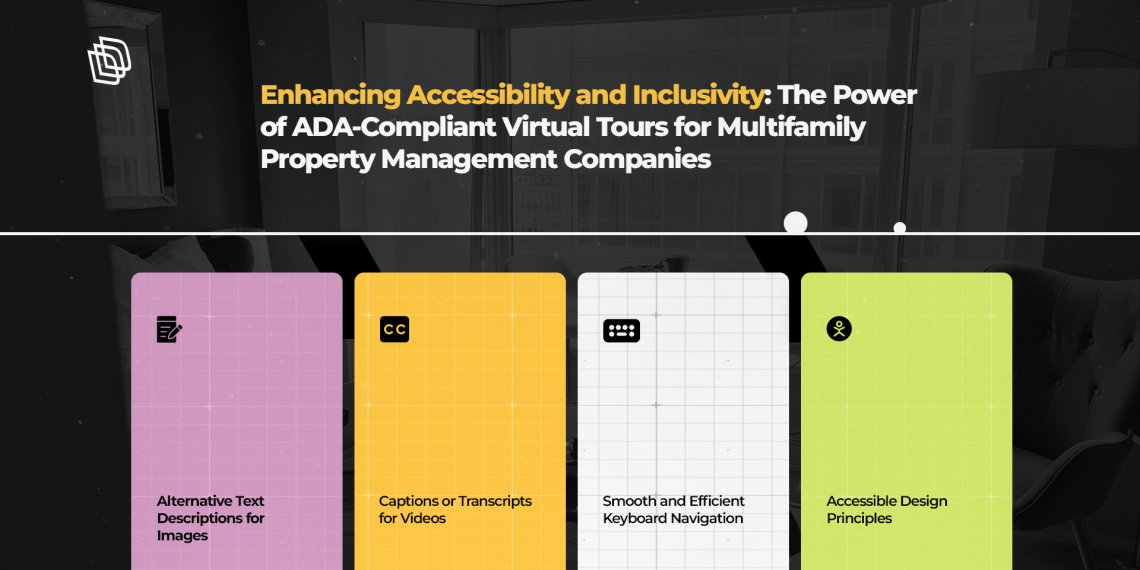As a multifamily professional, you understand the importance of providing equal access to all potential clients, including those with disabilities. In today’s digital age, virtual tours have become a critical tool for showcasing properties and attracting prospective residents. However, did you know that not all virtual tours are created equal when it comes to accessibility? Non-compliance with the Americans with Disabilities Act (ADA) standards in virtual tours can have serious consequences, including lawsuits and penalties. But fear not, because incorporating ADA-compliant virtual tours can not only mitigate these risks but also offer a myriad of benefits to your business and your clients.
Why ADA Compliance Matters in Virtual Tours
The ADA is a federal law that prohibits discrimination against individuals with disabilities and mandates accessibility in various aspects of public life, including websites and digital content. Virtual tours, being a form of digital content, are subject to ADA compliance requirements. Failing to meet these requirements can result in costly lawsuits and penalties, tarnishing your brand reputation and causing financial harm to your business. In recent years, there has been a rise in lawsuits against businesses for non-compliance with ADA standards in virtual tours, with some resulting in substantial settlements. For instance, in 2019, a national hotel chain settled a lawsuit for $75,000 for not providing accessible virtual tours on its website, and a real estate company faced a lawsuit seeking $200,000 in damages for similar reasons. These cases highlight the importance of ensuring ADA compliance in virtual tours to avoid legal repercussions.
Enhancing User Experience for All
Apart from the legal implications, ADA-compliant virtual tours also offer significant user experience benefits. Accessibility is not just a legal requirement, but also a moral imperative. Providing equal access to your property listings through virtual tours demonstrates your commitment to inclusivity and creates a positive impression among potential clients. Moreover, accessible virtual tours improve the overall user experience for all users, not just those with disabilities. Features such as screen reader compatibility, easy navigation, and adjustable font sizes benefit everyone, including older adults, individuals with temporary disabilities, and those with situational impairments, such as limited mobility due to carrying packages or holding a baby. By implementing ADA-compliant features, you ensure that your virtual tours are user-friendly and accessible to a wider audience, thereby increasing your potential client base.
Practical Considerations for ADA-Compliant Virtual Tours
Making virtual tours ADA compliant may seem daunting, but with the right approach, it can be a straightforward process. Here are some practical considerations to guide you:
- Alternative Text Descriptions for Images: Images used in virtual tours should have alternative text descriptions (alt-text) that are concise and descriptive. Alt-text allows individuals who are visually impaired to understand the content of the images using screen readers.
- Captions or Transcripts for Videos: Videos used in virtual tours should be captioned or accompanied by transcripts. Captions or transcripts ensure that individuals who are deaf or hard of hearing can access the auditory content of the videos.
- Smooth and Efficient Keyboard Navigation: Virtual tours should be designed to allow smooth and efficient keyboard navigation. This ensures that individuals who use keyboard navigation, such as those with mobility impairments, can navigate through the virtual tour easily and interact with all the content.
- Accessible Design Principles: Virtual tours should adhere to accessible design principles, such as sufficient color contrast and clear layouts. This ensures that the content is visually accessible to individuals with visual impairments or color blindness.
3D Apartment’s innovative Accessible tour package includes all of these features and can be added to your existing Matterport tours without the need to re-capture. Need updated or new virtual tour capturing? 3D Apartment can help with that as well!
In conclusion, incorporating ADA-compliant virtual tours in your multifamily property management company is not only a legal requirement but also a strategic move towards inclusivity and accessibility. By ensuring that your virtual tours meet ADA standards through features such as alternative text descriptions, captions or transcripts, smooth keyboard navigation, and accessible design principles, you can provide equal access to property listings and improve the overall user experience for all potential clients. Real-life examples and success stories demonstrate the positive impact of ADA-compliant virtual tours, showcasing how businesses that have implemented these features have not only avoided legal repercussions but also reaped the benefits of enhanced accessibility, inclusivity, and client satisfaction. Don’t miss out on the opportunity to showcase your properties to a wider audience and create a positive impression by making your virtual tours ADA-compliant today!


